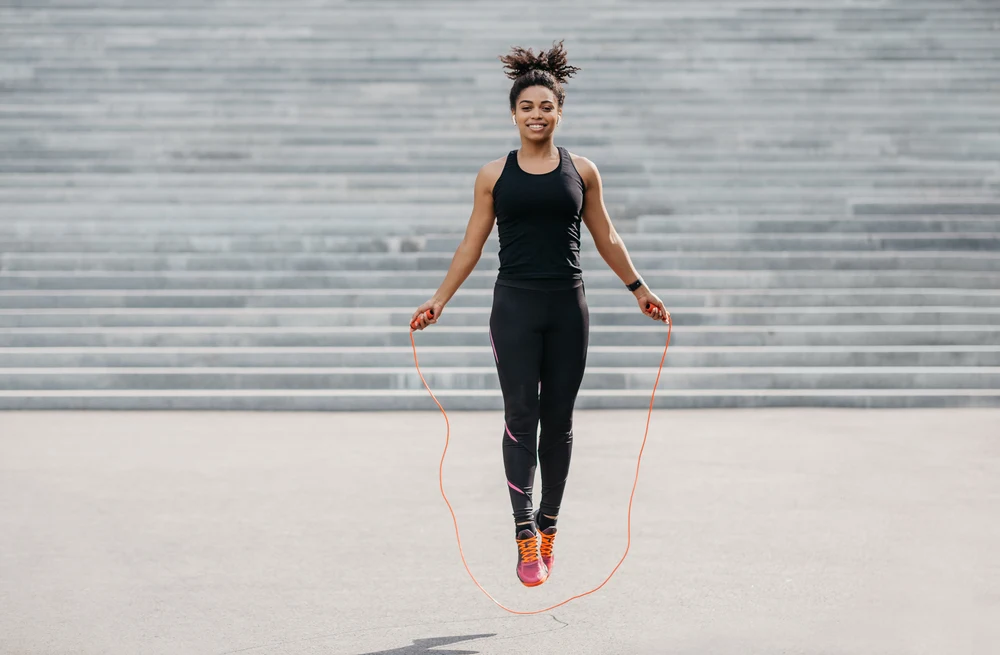Plyometrics are dynamic exercises that can help improve strength, power, balance, and agility. It's important for beginners to start slow and with simple exercises.
What are plyometrics?
Plyometric training involves engaging in short, intense bursts of activity that specifically target fast-twitch muscle fibers in the lower body. These fibers play a crucial role in generating explosive power, which can enhance speed and jumping ability.
Competitive athletes in sports like basketball, volleyball, baseball, tennis, and track and field often incorporate plyometrics into their training routines. Additionally, plyometrics can also enhance coordination, agility, flexibility, and provide a great cardiovascular workout.
Who can safely try plyometrics?
There are various types of plyometric exercises, and many people are familiar with gym plyometrics that involve jumping onto boxes or over hurdles. However, these advanced moves should only be attempted under the supervision of a trainer once you have developed some skills and muscle strength.
It's essential to note that even the beginner-level plyometrics mentioned in this article can be challenging. If you have experienced joint issues, particularly in the knees, back, or hips, or struggle with balance, it's advisable to consult with your doctor before attempting any plyometric training.
How to maximize effort while minimizing the risk of injury
To ensure safety during plyometric exercises, consider the following tips:
1. Choose a surface with some elasticity. Opt for a thick, firm mat (not a thin yoga mat), a well-padded carpeted wood floor, or grass/dirt outdoors. These surfaces can absorb some of the impact upon landing. Avoid jumping on hard surfaces like tile, concrete, or asphalt.
2. Start with small jumps. Begin by jumping just a few inches off the ground. Remember, the higher you jump, the greater the impact upon landing.
3. Maintain proper form. Bend your legs when you land and avoid locking your knees. Aim to land softly, distributing the impact throughout your feet rather than solely on your heels or toes.
Three simple plyometric exercises for beginners
Here are three beginner-level plyometric exercises to kickstart your training:
1. Side jumps
- Start by standing tall with your feet together.
- Shift your weight onto your right foot and leap as far as possible to your left, landing with your left foot first, followed by your right foot.
- Repeat the movement, hopping to your right. This completes one repetition.
- You can hold your arms in front of you or let them swing naturally.
- Avoid hunching or rounding your shoulders forward during the jumps.
- To make this exercise easier, hop a shorter distance and stay closer to the ground.
- Complete five to fifteen repetitions to finish one set. Aim for one to three sets, resting between each set.
2. Jump rope
- Jumping rope is an effective plyometric exercise that emphasizes short, quick ground contact time.
- Begin with two minutes of jumping rope and gradually increase the time or add extra sets.
- If two minutes is too challenging, break it up into 10- to 30-second segments.
- If your feet get tangled, pause until you regain your balance before continuing.
- An easier alternative is to mimic the motions of jumping rope without an actual rope.
3. Forward hops
- Stand tall with your feet together.
- Bend your knees and jump forward one to two feet.
- Turn your body around and jump back to the starting position, completing one repetition.
- Let your arms swing naturally during the hop.
- To make this exercise easier, hop a shorter distance and stay closer to the ground.
- For a greater challenge, hop farther and higher. As you progress, you can introduce small hurdles, starting with a stick and gradually increasing the height using books of various thicknesses.
- Complete five to ten hops to finish one set. Aim for one to three sets, resting between each set.
Remember to listen to your body and start with exercises that match your fitness level. It's always better to gradually progress and avoid pushing yourself too hard too soon. Enjoy your plyometric training journey!

